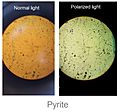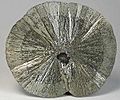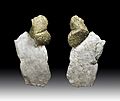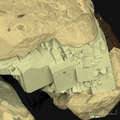Pyrite facts for kids
Quick facts for kids Pyrite |
|
|---|---|
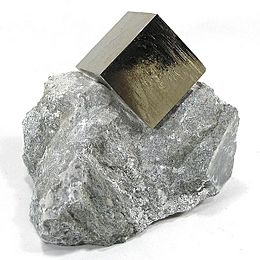 |
|
| General | |
| Category | Sulphide mineral |
| Formula (repeating unit) |
iron disulfide (FeS2) |
| Identification | |
| Color | Pale brass-yellow, tarnishes darker and iridescent |
| Crystal habit | Cubic |
| Crystal system | Isometric Diploidal, Space group Pa3 |
| Mohs scale hardness | 6–6.5 |
| Luster | Metallic, glistening |
| Streak | Greenish-black to brownish-black; smells of sulphur |
| Specific gravity | 4.95–5.10 |
| Solubility | Insoluble in water |
| Other characteristics | paramagnetic |
The mineral pyrite, or iron pyrite, is an iron sulfide with the formula FeS2. This mineral's metallic lustre and pale-to-normal, brass-yellow colour have earned it the nickname fool's gold because of its resemblance to gold. The term pyrite may also be used for some other sulphides such as copper sulphide.
History
Pyrite is the most common of the sulphide minerals. In ancient Roman times, this name was applied to several types of stone that would create sparks when struck against steel; Pliny the Elder described one of them as being brassy, almost certainly a reference to what we now call pyrite. By Georgius Agricola's time, the term had become a generic term for all of the sulphide minerals.
Pyrite is usually found associated with other sulphides or oxides in quartz veins, sedimentary rock, and metamorphic rock, as well as in coal beds, and as a replacement mineral in fossils. Despite being nicknamed fool's gold, pyrite is sometimes found in association with small quantities of gold.
Images for kids
-
An abandoned pyrite mine near Pernek in Slovakia
-
Pyritohedron-shaped crystals from Italy
-
As a replacement mineral in an ammonite from France
See also
 In Spanish: Pirita para niños
In Spanish: Pirita para niños



